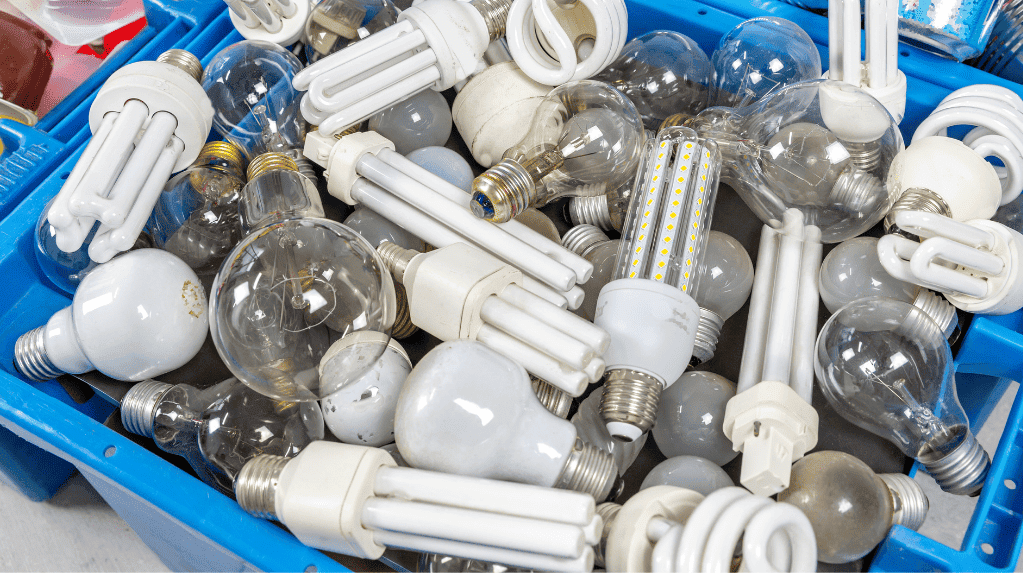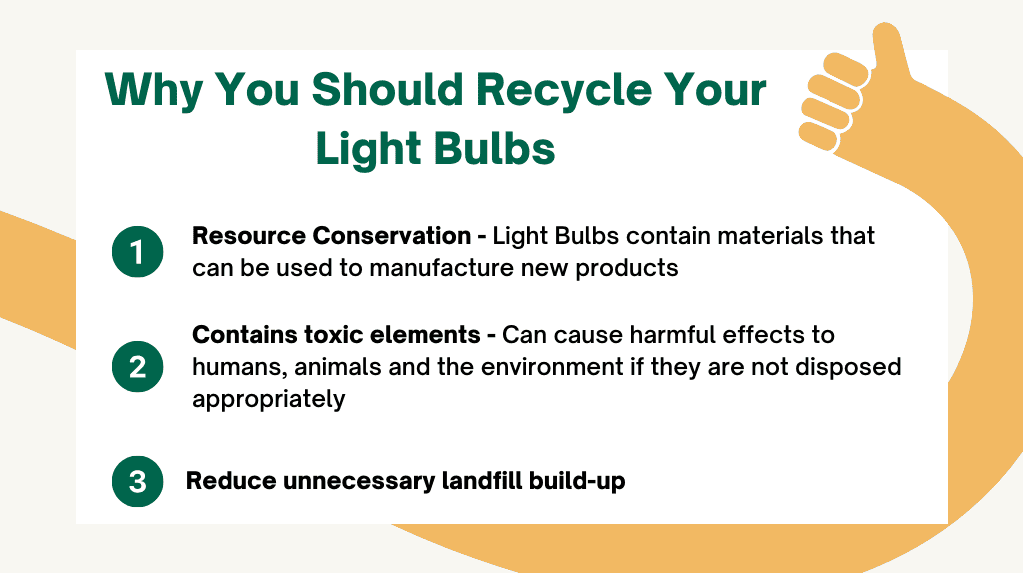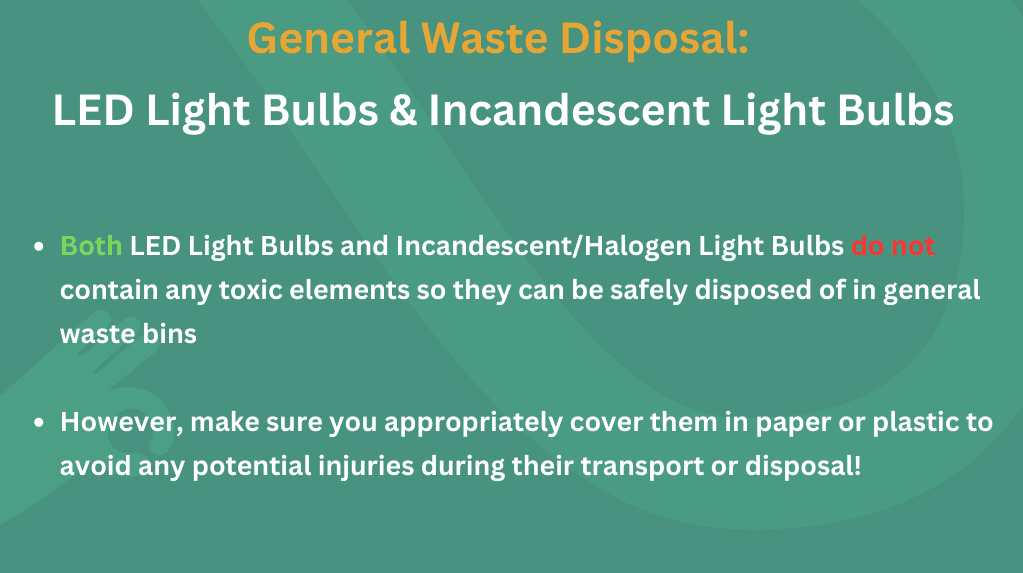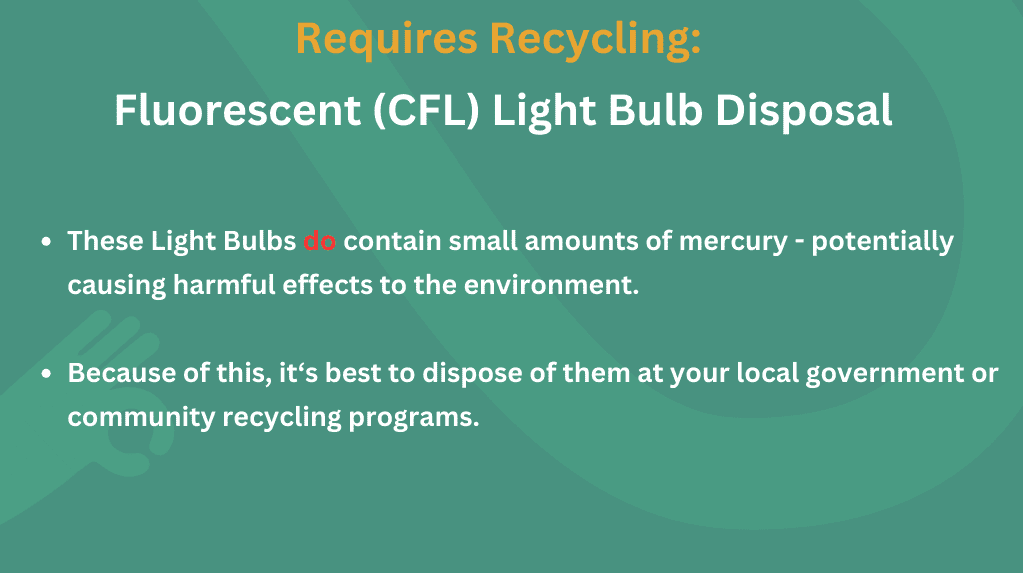
When old light bulbs blow out or get replaced, many Australians make the mistake of tossing them into the bin instead of properly disposing of them.
The average home in Australia has close to 37 light bulbs providing daily lighting, from table lamps to ceiling lights. Thanks to improvements in light bulb technology and the introduction of more efficient models of LED bulbs over the years, the lifespan of lightbulbs has increased significantly. Gone are the days where you’d get 2-3 years from halogen bulbs - we’re now looking at a lifespan of more than 15 years for LED light bulbs, which means a reduction in the replacement rate for light bulbs.
However, even long-lasting LED light bulbs will eventually reach the end of their lifespan, and when that happens, they should be properly disposed of. In this article, we’ve outlined a guide to how you can properly dispose of light bulbs - whether they are old halogen bulbs, LED light bulbs, or fluorescent light bulbs, to conserve resources and avoid adding to landfills.
Table of Contents
- The Importance of Proper Light Bulb Disposal
- How to Dispose of Old/Broken Light Bulbs
- LED Light Bulb Disposal
- Incandescent/Halogen Light Bulb Disposal
- Fluorescent (CFL) Light Bulb Disposal
- The Recycling Process for Light Bulbs
The Importance of Proper Light Bulb Disposal

With over 9.275 million Australian households (2021 ABS Census Data) turning on and off residential lighting in their homes every day, it’s no surprise that over 20 million light bulbs end up dumped in landfills each year.
However, light bulbs should not be dumped in landfill. Most people don’t realise that light bulbs need to be carefully disposed of and recycled.
Why? Well, the primary reason to recycle light bulbs is resource conservation. Light bulbs contain glass, metals and phosphor powder that can all be efficiently recycled to produce other goods such as glass wool for home insulation, metal products, and even fertiliser for use in agriculture from the phosphor powder. Recycling light bulbs ensures that these materials don’t go to waste lying in a landfill, as they can offer additional use in the manufacturing of new products.
Aside from being able to reuse leftover materials, it’s also important to recycle light bulbs as they contain toxic elements. In particular, fluorescent tubes or compact fluorescent lamps (CFLs) contain a small amount of mercury. Mercury can cause mercury poisoning in humans and other wildlife and will cause significant damage to the environment if it accumulates in landfills and leaks into water streams.
This is why proper light bulb disposal is so important - recycling your bulbs can help protect our world from contamination and unnecessary landfill build-up.
How to Dispose of Old/Broken Light Bulbs
Disposing of your used or unwanted light bulbs starts with identifying what type of bulb it is. As mentioned earlier, some light bulbs contain toxic complements that will require careful handling during the disposal process. Here are the ways to identify and dispose of different types of light bulbs:

LED Light Bulb Disposal
LED light bulbs are the most efficient type of lighting so far, with lifespans that last up to 5-10 times longer than traditional halogen light bulbs while using up to 85% less electricity. Most modern homes and commercial spaces in Australia have already made the switch to LED light bulbs, but if you need help identifying one, try to look for the lighting elements in the bulb or tube. LEDs typically have many lighting elements in a circle around the globe and tend to glow a slightly yellowish-orange colour just after they are switched off.
Since LED lamps do not contain toxic materials, they can safely be placed in rubbish bins for disposal, but recycling them is the better option. Take them to a recycling centre nearby, or a business that accepts old LED light bulbs. If your old LED lamp is not broken, cover it in paper or plastic before moving it to avoid it from shattering and potentially hurting someone during transport.
Incandescent/Halogen Light Bulb Disposal
Having been outdated by LED light bulbs, incandescent and halogen light bulbs are relics that are rarely used in modern household settings. Some are still being used, however, which is why we’ve included this section on how to dispose of them properly. Similar to LED light bulbs, they don’t contain any toxic materials, which makes them easy to dispose of in general waste bins. Be sure to wrap old incandescent or halogen bulbs in paper or plastic as well to avoid the glass bulb from breaking when disposing of it.

Fluorescent (CFL) Light Bulb Disposal
Compact fluorescent lamps (CFLs), fluorescent tubes, and even neon signs are the tricky ones to dispose of. They contain small amounts of mercury which are too minute to cause serious harm to humans, but can contribute to mercury accumulation in landfills and lead to environmental contamination from mercury poisoning. For this reason, it’s advisable to always recycle them at designated council recycling centres that will be able to safely isolate and extract their mercury content.
Identifying fluorescent bulbs can be done by checking the identification number located on its ends. If the first letter of the number is “F”, this indicates that the light bulb is a fluorescent type.
Once you’ve wrapped the fluorescent bulb in a protective layer to prevent it from breaking, you can take it to local government or community recycling programs. Examples of where you can check approved drop-off locations can be found on FlouroCycle, or Recycling Near You.
Recycling — The Best Way to Dispose of Light Bulbs
An estimated 95% of all fluorescent lamps in Australia end up being dumped in landfills each year, which contributes to the ever-growing problem of e-waste. By doing your part to dispose of light bulbs sustainably through recycling channels, you can help contribute to efforts in curbing this problem. Surveys have shown that Australians are aware of the importance of recycling, but not all are committed to practising it.
As dedicated members of Sydney’s community, we want to make proper recycling more accessible to Sydneysiders. If your household or business needs to dispose of lightbulbs, but aren’t sure of how to do it or simply don’t have the time, we’re here to help. Ridly Rubbish Removal can collect and dispose of your old light bulbs safely and responsibly on your behalf, whether they are halogen bulbs, LED light bulbs, or fluorescent lamps. With our same-day removal services starting at just $69, you can leave the proper disposal for light bulbs to us and get on with the rest of your day. Give our friendly team a call today to find out how we can help.